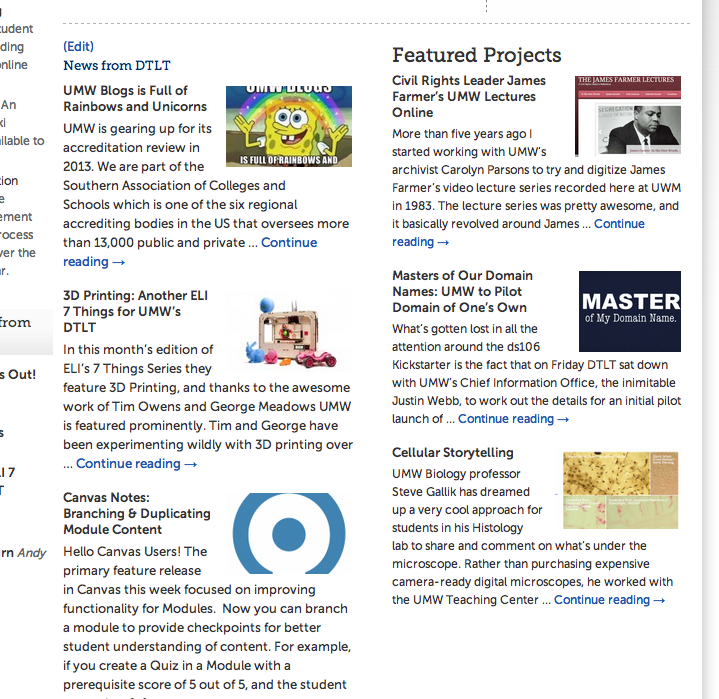
Image credit: http://grettajohnson.com/perez.html
I’ve been following the explosion of all things MOOC over the last few weeks somewhat quietly, the hype has even come home to roost at UMW in some odd ways. It’s been at once exciting and disquieting to watch. I’m excited for the folks like Siemens, Downes, and Cormier who framed the concepts and ideas behind the term and experimented wildly with its possibilities ever since. On the other side, I am pretty spooked by how denatured the term and its various meanings have become. And whether or not you try and break it up into categories, subsets, etc., the term MOOC—along with whatever ills or benefits people assign to it—has created a dramatic impact. Most of that impact right now is still based in media reaction, but it’s fascinating to see how quickly that translates into real decisions by major elite institutions.
I’m pretty excited about the possibilities for online education in the future, I’m just not so sure if the packaging of this idea by companies like Coursera partnered with elite universities is a solid, sustainable approach. I’m still not entirely sure, either is Coursera it seems, but kudos to Jeff Young for his recent College 2.0 article “Inside the Coursera Contract: How an Upstart Company Might Profit From Free Courses”. The article focuses on the contractual elements of the deal between the University of Michigan and Coursera (thank god for public institutions and the FOIA!). It’s the best article I’ve read yet on the venture capital, wholesale model MOOCs because it breaks down what is at the bottom of this movement: false profits and fear. Read the article, but below are some pull quotes for me—some priceless stuff. If you are not afraid of the ideas and basic lack of imagination steering the elite universities vision for online learning you should be! [All emphasis mine]
The contract reveals that even Coursera isn’t yet sure how it will bring in revenue. A section at the end of the agreement, titled “Possible Company Monetization Strategies,” lists eight potential business models, including having companies sponsor courses. That means students taking a free course from Stanford University may eventually be barraged by banner ads or promotional messages.
Kinda like #ds106 brought to you by Halliburton, making stories that touch everyone with a Kevlar vest!
“We have a lot of white boards up around the office where these ideas are being written down and erased and written down and erased,” he says. Still, that brainstorm list has some surprises, including the idea of selling course content from universities to companies to use for internal training.
Coursera is not open education, please repeat that 3x. Also, they are selling the universities work in the form of delivered courses, but of course they claim no ownership as you’ll read later on.
Coursera is following an approach popular among Silicon Valley start-ups: Build fast and worry about money later. Venture capitalists—and even two universities—have invested more than $22-million in the effort already. “Our VC’s keep telling us that if you build a Web site that is changing the lives of millions of people, then the money will follow,” says Daphne Koller, the company’s other co-founder, who is also a professor at Stanford.
That previous quote truly scared me. Basically Daphne Koller has conceded all agency to Venture Capitalists. When your business plan sounds like the catch phrase of a bad Kevin Costner movie that should raise some red flags.
Officials at the University of Michigan were not immediately available for comment about their contract.
I can’t imagine why not, maybe because they realized they jumped on the bandwagon a bit too early and people are starting to realize there is no there there.
When and if money does come in, the universities will get 6 to 15 percent of the revenue, depending on how long they offer the course (and thus how long Coursera has to profit from it). The institutions will also get 20 percent of the gross profits, after accounting for costs and previous revenue paid. That means the company gets the vast majority of the cash flow.
So the universities provide the brand (and in these contracts that is exactly what it is!) and the professor (and as a result I would hope the content), in return they get a small fraction of the profit. What’s more…
Another detail that seems unresolved in the rush to offer free online courses is whether professors should share in the spoils. Peter Rodriguez, an associate professor and senior associate dean for degree programs at the University of Virginia’s Darden School of Business, was involved in the university’s contract negotiations with Coursera. He says that, as it stands, professors do not get a royalty from the courses, but that, “in the long run, that’s possible.”
Teach 100,000 people but don’t ask for more money you spineless cretin. You are the brains, that’s all, now shut up and teach!
When I showed the Coursera contract to Trace A. Urdan, an analyst at Wells Fargo Securities who focuses on education-related companies, he found it “ironic” that major universities are embracing online education when they have been dismissive of earlier efforts by for-profit companies like the University of Phoenix.
“These are two of the most arrogant types of institutions—Silicon Valley companies intersecting with these elite academic programs,” he says. “Neither of them considers that anyone else has come to this place before they’ve arrived. They say, We’re here now, so now it’s sort of legitimate and for real.”
And he argues that the plan relies heavily on all of the money colleges are already spending on professors and facilities. “It’s a way to carve out some extra money on the top of the existing program, but it’s not an alternative system that is going to solve the cost crisis of higher education,” he says. “It’s being subsidized by incredibly high-priced education.”
I never thought I would like quotes from a financial securities analyst as much as I liked those above. Public and private educational institutions will ultimately be subsidizing a model that will evaporate as soon as they stop investing in it—how is that sustainable again? There’s no structure outside of the existing one in this model. The myth that this model will somehow replace institutions couldn’t be more evident from this set of quotes. But could it result in professors teaching leagues of students for no more money, and as a result fewer full-time tenured faculty positions in an already dismal pool of jobs? Yes. Is that good? No. I truly believe dismantling research and teaching institutions by ending tenured positions for the professorate poses deep risks to any nation’s freedom.
Ms. Koller insists that the courses the company is offering differ fundamentally from those at the University of Phoenix. “Their online effort is really traditional teaching mediated by the computer as opposed to using the tech in a fundamental way,” [what does this even mean?] she argues. “There’s no economies of scale there. What we’re doing is one instructor, 50,000 students. This is the way to bend the cost curves.”
How is what Coursera is doing different in terms of design from what the University of Phoenix is doing beyond scale? The scale of MOOCs is all they have been reduced to, the massive has taken over, the rest is always already secondary. Ms. Koller sounds like a politician in all the worst ways here, how did she and Ng let themselves be quoted like this so regularly? I think that is what scares me most, they actually believe what they are doing is some form of liberation for anyone.
College officials, for their part, seem more motivated by fear than by the promise of riches. “Most of us are thinking this could be a loss of revenue source if we don’t learn how to do it well,” says Mr. Rodriguez, of the University of Virginia. “These are high-quality potential substitutes for some of what universities do.”
UVa? Isn’t that the school that was just liberated from all this? 😉 Say what you will, I can’t help but agree with Jeff Young’s final assessment: the headlong jump into the idea of MOOCs is all about fear. But in this case I hope it won’t last longer than thoughtful, imaginative approaches to online learning.











